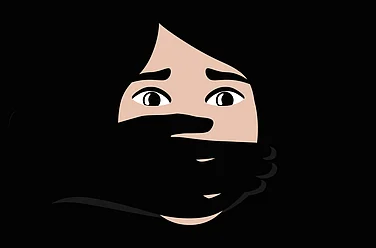Between conception and cremation, a Hindu was to have his lifespan punctuated by a total of 16 major samskaras (‘rites of passage’ or ‘initiation ceremonies’) out of which the upanayana samskara is one of the few that still survive in practice. It was primarily meant as an enabler for the study of the Vedas and performance of Vedic sacrifices. Therefore, it is available only to male members from the first three tiers of classical Hindu society, namely, Brahmins, Kshatriyas, and Vaishyas, who can be approximately (if somewhat inaccurately) understood as the intellector class, the warrior class, and the mercantile class respectively. However, there are clear statements in Hindu religious literature to the effect that ‘in earlier times’, the initiation was extended to females also from these classes, and there are hints pointing to the ceremony being inclusive enough to cover members from the fourth class as well. However, it is unambiguous that males from the first three classes are entitled to upanayana. It is the ‘second birth’, which makes them dvi-ja, that is, ‘twice-born’.
The rite enjoins the wearing of a ceremonial string, named the yajnopaveeta (janeu in Hindi). Since it was available only to ‘upper-caste’ Hindus, it also became a desirable symbol and many Hindus would wear it—regardless of the classically given entitlement—in order to demonstrate that they belonged to a ‘high caste’. In particular, it came to be adopted in many caste-based ‘reform movements’ that came up in the late nineteenth and early twentieth centuries. Before that, however, it seems that the non-Brahmins stopped being particular about wearing it long ago in history and the association of the yajnopaveeta with the Brahmin had grown to be nearly exclusive.
The visibility and physicality of this string ensured its empowerment in terms of symbolism and survival so that gradually it came to be taken as not only the medium, but also the message of the Brahmin as a social significatum. Thus, Tulsidas makes his Ram repeatedly say that but for the yajnopaveeta worn by Parashuram, which indicates Parashuram is a Brahmin and thus enjoys immunity against violence, Ram would have reacted violently to his invectives. But the yajnopaveeta is also an enabler for performance of karmic duties, so that a sanyasin, who is seeking only liberation from this world, abjures it when he dons the ochre robe.
The making of a yajnopaveeta was, till a few years ago, essentially a household activity of a Brahmin family. The women would raise a three-strand twine from cotton from which a length of 96 units was taken, one unit being four finger-breadths of a hand. The measurement is dictated by the hand of the man who prepares the yajnopaveeta finally. This length is then folded into three, resulting in a nine-strand twine. This is tightly twisted and a string is made which is then knotted at one end. The number of knots can be one, or three, or five, depending on the gotra (the ‘clan’) of the end-user. It stands for the number of pravaras (distinguished ancestors) associated with each gotra. The gotra and pravara listings are complex and detailed in texts written long ago.
The significance of the 96 units is explained variously. One is that the Gayatri mantra has 24 syllables and is representative of the Vedas, so a total of 96 syllables represents the four Vedas—and the yajnopavita thus stands for the entire Vedic corpus. The nine strands stand for nine gods, namely, (1) Om, (2) Agni, the fire, (3) the snake-gods, (4) Soma, the moon-god, (5) the manes, (6) Prajapati, the creator, (7) Anila, the wind-god, (8) Yama, the death-god, and (9) the totality of all the gods. Some authorities supply a variant of this list.
Each of these gods is duly installed in the particular strand by the chanting of a mantra. In fact, each step of the male contribution to the manufacture of a yajnopaveeta is consecrated by a mantra. Some regard the nine strands as representative of the nine ‘virtues’ a Brahmin possesses as given in the Gita (18-42). But today, the thread is commercially available in the market—just a nine-strand twine produced from cotton—and erudite labour is no longer a required input.
Mentioned in the earliest Vedic literature, the yajnopaveeta almost certainly originates from the same source as kushti, the Zoroastrian girdle. Thus from a historical point of view, it comes from the hoary Indo-Iranian past. Some modern scholars assert, however, that it’s a latter-day substitute for the upper garment. Be that as it may, the full significance for the Hindu system can be appreciated only by examining the upanayana and the ancient education system.
The upanayana initiation was done early; the initiates were usually aged eight, if not younger. It was done by a teacher and amounted to a formal admission to the education system, as distinct from the kindergarten education provided earlier. Usually, if a new teacher was approached, the ceremony was at least symbolically repeated. Since Vedic teaching was done by Brahmins, this initiator was invariably a Brahmin, but we do have examples in Vedic literature when for the teaching of Upanishadic knowledge, Kshatriyas took senior Brahmins as students. For a Brahmin boy, this teacher is supposed to be his father, but Vedic literature supports the conclusion that the practice was to send the boy for higher studies at least to reputed external teachers.
There was no fee, and the first job of the boy just after initiation was to ask for alms to support the family of his teacher, the family of which he was now a part. The first alm-giver was to be the mother of the boy, in what seems a deliberately emotional kickstart to a new life in a home away from home. The formula for begging was a ritualised three-word sentence: “Lady, give alms” for the Brahmin boy, “Give, lady, alms” for the Kshatriya boy, and “Give alms, lady” for the Vaishya boy. The yajnopaveeta of the Brahmin boy was made from cotton, that of the Kshatriya boy from hemp, and that of the Vaishya boy from sheep wool. Incidentally, the Zoroastrian kushti is also made of sheep wool.
The boys had to carry a staff made of wood, but the prescribed trees whose wood was to be used also differed depending on which of the three classes the boy came from. The height of the staff was to be up to the hair for a Brahmin, up to the forehead for a Kshatriya and up to the nose for a Vaishya. Thus the ‘class distinction’ continued into school, but we have no way of knowing whether these rules were actually observed. In historical times, relaxation rather than enforcement seems to be the norm: the yajnopaveeta is made of cotton for everybody and non-Brahmins do not seem to opt for the study of the Vedas.
The life of a student was hard. The teachers meant well but enforced discipline strictly. Every aspect of life was strictly regulated. All functionalities, from food to personal hygiene, were governed by a series of dos and don’ts, and nothing was supposed to move without the teacher’s permission. This harsh life was to be endured for about twelve years, and then at last the teacher would declare that the student had studied enough to enable him to move out into the world on his own, marry and raise a family, find means for supporting this family and so on. This declaration was regarded as the award of a degree.
There would now be a ‘convocation’, for this one student. This was another samskara, the samavartana samskara. Literally, this meant the ‘rite of passage of returning (to the normal life)’. This was in contrast to the upanayana samskara which meant the ‘rite of passage of being taken away (from normal life) and near (the teacher)’. Education was a life in another world. (For some time, the system has been miniaturised and samavartana follows upanayana within hours.)
At this point, the student would ask the teacher to name a fee. The teacher would generally waive it—going out into the world and serving society would be sufficient payment. Most students were in no position to pay anyway. However, Lord Krishna was asked by his teacher’s wife to bring her son back to life, and he did. As he did not do the same for his own mother by resurrecting his dead siblings, this is not a mere demonstration of his powers—it highlights the idea that education is invaluable.
After the samavartana, one could relax if possible. If one could afford it, one could eat well; there were no restrictions. Rich food and rich clothes were no longer forbidden. If one could get them. And the young man would now have to wear two yajnopaveetas instead of the one he had worn as a student. The yajnopaveeta was in some ways even more integral now. The basic codes continued to be obeyed. While micturating or defecating, the yajnopaveeta was to be mounted on the right ear. It was to be worn on the left shoulder while offering libations to gods. This style of wearing it was known as upaveeta and it is from this that the yajnopaveeta derives its name—it literally means ‘that which is worn in the upaveeta style while performing yajna’. This style was the default. It was to be worn on the right shoulder while offering libations to the manes and on the neck like a garland while offering libations to ‘divine humans’. In all positions, it was to stay above the navel.
It has to be presented to a son-in-law and some other distinguished guests as a gift. It is offered to the gods and the manes every time they are worshipped. It must be changed on the day the sun moves into Capricorn, on Holi, and on many other days of the year. It has to be changed each time a fresh religious activity is started. There are many such rules and even today, innumerable Brahmins follow them. And it has value in other ways. An oath ‘by the yajnopaveeta’ is one of the strongest. In an old play, Karna taunts Ashvatthama by saying the latter could not be killed because he is a Brahmin and Ashvatthama retorts by removing his yajnopaveeta and saying: “Ok, I am no longer a Brahmin, now kill me if you can”.

A performance of the ancient Sanskrit play Mrcchakatika
In our time, this performance is repeated in another theatre: egalitarians ‘declass’ themselves by removing their yajnopaveetas. But the zunnara, as it is called in Persian, is a sign of non-conformism in Persian and Urdu poetry. In an ancient Sanskrit play, Mrcchakatika (The Little Clay Cart), a thief lists some uses of the yajnopaveeta not mentioned in any book which talks about the upanayana samskara:
With this he measures, ere he pierce a wall,
And picks the lock, when jewels are at stake.
It serves as key to bolted door and hall,
As tourniquet for bite of worm and snake.
(Act 3, verse 16), (translation by Arthur Ryder)
This was written when the yajnopaveeta still INSpired respect; it illustrates an artist’s freedom to mock. Two millennia on, in a subversion of Marx, the creative farce is etching itself back into banal history and the yajnopaveeta is now a significator of the deteriorata of Indian society. Lampooned and hated as a supremacist symbol, it has been robbed of its cultural juice and has shrivelled. Almost as if the helical staircase tired of being called a spiral staircase and decided to yield to the linguistic falsification by shedding a dimension.
(The writer is an Indologist and retired teacher of mathematics at IIT-Delhi)





















